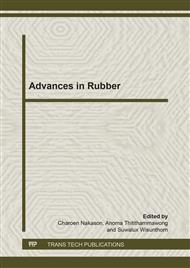p.198
p.201
p.205
p.209
p.217
p.221
p.225
p.229
p.235
Influence of the Type of Alkylamine Organic Modifiers on Thermal Mechanical Behavior and other Related Properties of Natural Rubber/Clay Nanocomposites
Abstract:
Sodium-montmorillonite (Na-MMT) nanoclay was modified with different types of alkylamine organic modifier including primary and quaternary alkylamines. Influence types of alkylamine on properties of natural rubber/clay nanocomposites was investigated. It was found that organoclays caused improvement of mechanical properties of natural rubber, and accelerated vulcanization reaction with higher degree of crosslinking. In addition, organoclay modified with quaternary alkylamine showed significance cure reversion phenomenon which caused reduction of thermal stability. On the other hand, primary alkylamine modified nanoclay caused improvement of thermal stability of natural rubber. Moreover, stress relaxation was observed at the melting temperature of the modifying agent.
Info:
Periodical:
Pages:
217-220
Citation:
Online since:
November 2013
Price:
Сopyright:
© 2014 Trans Tech Publications Ltd. All Rights Reserved
Share:
Citation:


